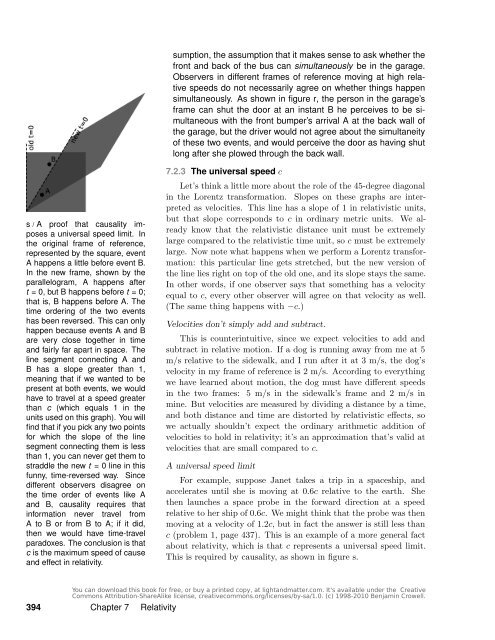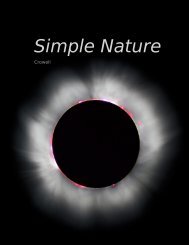The size of a radio antenna is closely related to ... - Light and Matter
The size of a radio antenna is closely related to ... - Light and Matter
The size of a radio antenna is closely related to ... - Light and Matter
You also want an ePaper? Increase the reach of your titles
YUMPU automatically turns print PDFs into web optimized ePapers that Google loves.
sumption, the assumption that it makes sense <strong>to</strong> ask whether the<br />
front <strong>and</strong> back <strong>of</strong> the bus can simultaneously be in the garage.<br />
Observers in different frames <strong>of</strong> reference moving at high relative<br />
speeds do not necessarily agree on whether things happen<br />
simultaneously. As shown in figure r, the person in the garage’s<br />
frame can shut the door at an instant B he perceives <strong>to</strong> be simultaneous<br />
with the front bumper’s arrival A at the back wall <strong>of</strong><br />
the garage, but the driver would not agree about the simultaneity<br />
<strong>of</strong> these two events, <strong>and</strong> would perceive the door as having shut<br />
long after she plowed through the back wall.<br />
s / A pro<strong>of</strong> that causality imposes<br />
a universal speed limit. In<br />
the original frame <strong>of</strong> reference,<br />
represented by the square, event<br />
A happens a little before event B.<br />
In the new frame, shown by the<br />
parallelogram, A happens after<br />
t = 0, but B happens before t = 0;<br />
that <strong>is</strong>, B happens before A. <strong>The</strong><br />
time ordering <strong>of</strong> the two events<br />
has been reversed. Th<strong>is</strong> can only<br />
happen because events A <strong>and</strong> B<br />
are very close <strong>to</strong>gether in time<br />
<strong>and</strong> fairly far apart in space. <strong>The</strong><br />
line segment connecting A <strong>and</strong><br />
B has a slope greater than 1,<br />
meaning that if we wanted <strong>to</strong> be<br />
present at both events, we would<br />
have <strong>to</strong> travel at a speed greater<br />
than c (which equals 1 in the<br />
units used on th<strong>is</strong> graph). You will<br />
find that if you pick any two points<br />
for which the slope <strong>of</strong> the line<br />
segment connecting them <strong>is</strong> less<br />
than 1, you can never get them <strong>to</strong><br />
straddle the new t = 0 line in th<strong>is</strong><br />
funny, time-reversed way. Since<br />
different observers d<strong>is</strong>agree on<br />
the time order <strong>of</strong> events like A<br />
<strong>and</strong> B, causality requires that<br />
information never travel from<br />
A <strong>to</strong> B or from B <strong>to</strong> A; if it did,<br />
then we would have time-travel<br />
paradoxes. <strong>The</strong> conclusion <strong>is</strong> that<br />
c <strong>is</strong> the maximum speed <strong>of</strong> cause<br />
<strong>and</strong> effect in relativity.<br />
7.2.3 <strong>The</strong> universal speed c<br />
Let’s think a little more about the role <strong>of</strong> the 45-degree diagonal<br />
in the Lorentz transformation. Slopes on these graphs are interpreted<br />
as velocities. Th<strong>is</strong> line has a slope <strong>of</strong> 1 in relativ<strong>is</strong>tic units,<br />
but that slope corresponds <strong>to</strong> c in ordinary metric units. We already<br />
know that the relativ<strong>is</strong>tic d<strong>is</strong>tance unit must be extremely<br />
large compared <strong>to</strong> the relativ<strong>is</strong>tic time unit, so c must be extremely<br />
large. Now note what happens when we perform a Lorentz transformation:<br />
th<strong>is</strong> particular line gets stretched, but the new version <strong>of</strong><br />
the line lies right on <strong>to</strong>p <strong>of</strong> the old one, <strong>and</strong> its slope stays the same.<br />
In other words, if one observer says that something has a velocity<br />
equal <strong>to</strong> c, every other observer will agree on that velocity as well.<br />
(<strong>The</strong> same thing happens with −c.)<br />
Velocities don’t simply add <strong>and</strong> subtract.<br />
Th<strong>is</strong> <strong>is</strong> counterintuitive, since we expect velocities <strong>to</strong> add <strong>and</strong><br />
subtract in relative motion. If a dog <strong>is</strong> running away from me at 5<br />
m/s relative <strong>to</strong> the sidewalk, <strong>and</strong> I run after it at 3 m/s, the dog’s<br />
velocity in my frame <strong>of</strong> reference <strong>is</strong> 2 m/s. According <strong>to</strong> everything<br />
we have learned about motion, the dog must have different speeds<br />
in the two frames: 5 m/s in the sidewalk’s frame <strong>and</strong> 2 m/s in<br />
mine. But velocities are measured by dividing a d<strong>is</strong>tance by a time,<br />
<strong>and</strong> both d<strong>is</strong>tance <strong>and</strong> time are d<strong>is</strong><strong>to</strong>rted by relativ<strong>is</strong>tic effects, so<br />
we actually shouldn’t expect the ordinary arithmetic addition <strong>of</strong><br />
velocities <strong>to</strong> hold in relativity; it’s an approximation that’s valid at<br />
velocities that are small compared <strong>to</strong> c.<br />
A universal speed limit<br />
For example, suppose Janet takes a trip in a spaceship, <strong>and</strong><br />
accelerates until she <strong>is</strong> moving at 0.6c relative <strong>to</strong> the earth. She<br />
then launches a space probe in the forward direction at a speed<br />
relative <strong>to</strong> her ship <strong>of</strong> 0.6c. We might think that the probe was then<br />
moving at a velocity <strong>of</strong> 1.2c, but in fact the answer <strong>is</strong> still less than<br />
c (problem 1, page 437). Th<strong>is</strong> <strong>is</strong> an example <strong>of</strong> a more general fact<br />
about relativity, which <strong>is</strong> that c represents a universal speed limit.<br />
Th<strong>is</strong> <strong>is</strong> required by causality, as shown in figure s.<br />
394 Chapter 7 Relativity














